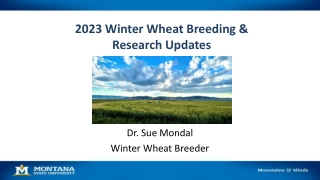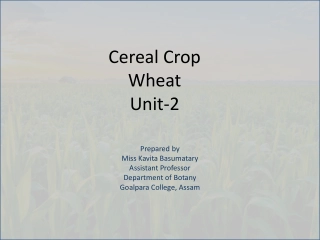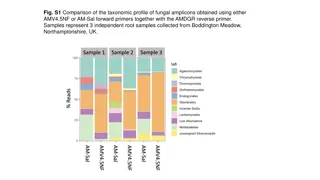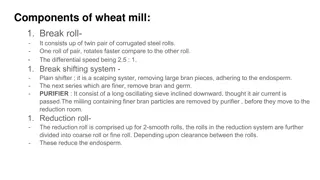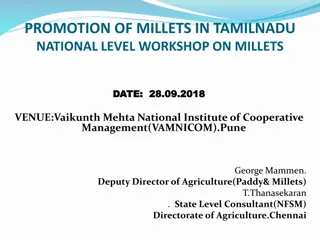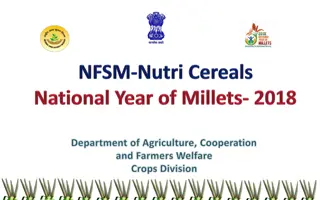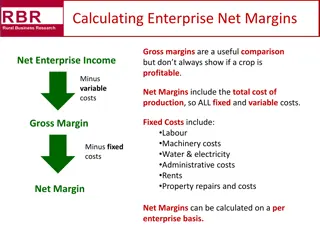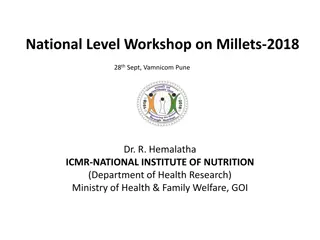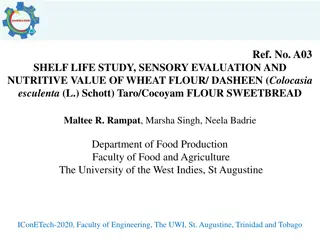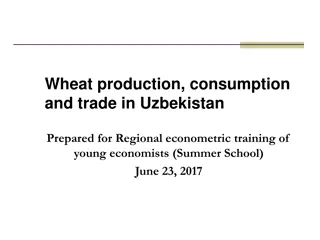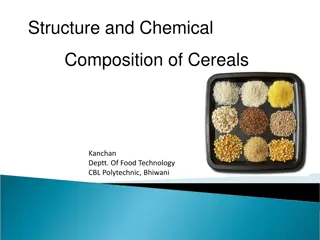Understanding Wheat and Millets: Structures, Types, and Processing
Wheat is a vital cereal crop categorized into hard and soft types, each suitable for various food products. The milling process involves cleaning, crushing, and reduction stages to produce different flours. Types of wheat include hard spring, hard red winter, soft, and durum. By-products of wheat milling, like bran and fine wheat feed, are used in animal feeds.
Download Presentation

Please find below an Image/Link to download the presentation.
The content on the website is provided AS IS for your information and personal use only. It may not be sold, licensed, or shared on other websites without obtaining consent from the author. Download presentation by click this link. If you encounter any issues during the download, it is possible that the publisher has removed the file from their server.
E N D
Presentation Transcript
Wheat and Millets: Structures, types and processing
WHEAT WHEAT Wheat is the one of the important cereal crop of the World, with an estimated annual production of 540 - 580 million metric tonnes. Wheat belongs to the genus Triticum of the grass family Gramineae. Common wheat (Triticum aestivum) and durum wheat (Triticum durum) are the two major wheat groups grown for food use now. Wheat is classified into two groups: hard and soft. Hard wheat is higher in protein compared to soft wheat. It yields stronger flour, which forms more elastic dough, and is better for bread making when strong elastic dough is essential for high leavened volume. Soft wheat is lower in protein, which forms weaker dough or batter, and is better for cake making.
STRUCTURE OF WHEAT. STRUCTURE OF WHEAT.
MILLING MILLING Milling of wheat is the process that turns whole grains into flours. The overall aims of the miller are to produce: A consistent product A range of flours suitable for a variety of functions Flours with predictable performance The very first mill operation is analyzing the grain, which determines criteria such as the gluten content and amylase activity. It is at this point that decisions about blending are made.
MILLING: THREE STAGES Cleaning and conditioning ridding the grain of all impurities and readying it for milling Crushing or breaking breaking down the grain in successive stages to release its component parts Reduction progressive rollings and siftings to refine the flour and separate it into various categories, called streams
TYPES OF WHEAT. TYPES OF WHEAT. Types of wheat optimum moisture content tempering time in hours of tempered wheat Hard spring wheat Hard red winter Wheat Soft wheat 16-17% 15.5-16.5% 36 24 10 14.5-15.5% Durum Wheat 16-17% 6
MILLING OF BY PRODUCTS. MILLING OF BY PRODUCTS. The by-products from wheat milling process are known as wheatfeed . They comprise bran, the coarse residue from break grinds, fine wheat feed, accumulated particles from the purifiers and reduction grinding. Bran and fine wheat feed are used in compound animal feeds.
MILLET MILLET The grasses known collectively as millets are a set of highly variable, small seeded plant species indigenous to many areas of the world. Millets are of value especially in semiarid regions because of their short growing season and higher productivity under heat and drought conditions. Pearl millet is the most widely grown millet and is a very important crop in India and parts of Africa. Finger millet is popular in East Africa and India. Foxtail and Proso millets are cultivated primarily in the Near East and China. Proso millet is also widely cultivated in the Russia Federation. Fonio and teff are grown in West Africa and Ethiopia, respectively. Pear millet is one of the earliest domesticated millets; carbonized grains have been found in sub-Saharan and West African sites inhabited 4000- 5000 years ago.
STRUCTURAL AND PHYSICAL PROPERTIES. STRUCTURAL AND PHYSICAL PROPERTIES. The millets can be divided into two types of seeds: utricles and caryopses. In the utricle, the pericarp surrounds the seed like a sac but is attached to the seed at only one point. Finger millet, proso and foxtail millets are utricles. In these millets, the pericarp usually breaks away from the seed coat or testa, which is well developed, thick and forms a strong barrier over the endosperm. In a caryopsis, the pericarp is completely fused to the seeds. Pearl millet, fonio and teff are caryopses. For pearl millet, the kernels are composed of the pericarp, endosperm and germ, which comprise 8.4, 75.1 and 16.5% of the total kernel weight, respectively. The endosperm comprises the majority of the kernel weight for all millets. There are four structural parts of the endosperm: the aleurone layer and the peripheral, corneous and floury endosperm areas
PROCESSING OF MILLET. PROCESSING OF MILLET. Milling separates the grain into three components, germ, endosperm and seed coat. Milling techniques practiced mostly depend on the end- use. Milling process starts with the cleaning of the grains, to remove unwanted impurities and broken grains, using vibratory sieves, aspirators and specific gravity separators. The cleaned grains are conditioned, by addition of water, to soften the endosperm.
TYPES OF MILLET. TYPES OF MILLET. 1. Sorghum (Jowar) Jowar is very popular millet and research has revealed that it is very beneficial for weight loss. If we remember, many grandmas prefer jowar rotis over regular wheat rotis, all thanks to its benefits. The calcium content in jowar is closely similar to the calcium content in wheat and rice. It is also packed with iron, protein, and fibre. Research has found that a typical sorghum wax is rich in policosanols which helps in reducing the levels of cholesterol. Since jowar is a gluten-free grain, even people who are gluten intolerant can have it. It is worth mentioning that millets solve nutrition-related problems since it is a rich source of micronutrients.
2. Foxtail millet Foxtail millets are available in the form of rice, semolina (Rava) or fine-textured flour. Like other millets, foxtail millet is rich in complex carbohydrates the kind which doesn t increase the blood sugar levels immediately but slowly releases glucose into the bloodstream. It is rich in dietary fibre and minerals like iron and copper. Due to this, it helps to reduce the levels of bad cholesterol and keeps the immune system strong as well.
3. Finger millet (ragi) Ragi is one of the most popular and commonly consumed millets. Due to its nutritional value, it can be considered a good replacement for rice and wheat. It is also a rich source of calcium and other essential minerals. Ragi is a storehouse of protein and amino acids that make it a good inclusion in porridge and even wheat flour. Studies have suggested that Ragi has a positive effect on blood glucose level and hence, it is a great option for people with diabetes.
4. Pearl millet (Bajra) A study has revealed that Pearl millet or Bajra has iron content 8 times higher than rice. Bajra is also rich in protein, fibre, and other minerals such as calcium and magnesium. Since it has good fibre content, pearl millet/Bajra will help ease constipation issues and any problems with digestion. Because of its nutritional value, it can also make for a good lactagogue. Therefore, it induces lactation and helps in efficient milk secretion.
5. Barnyard millet Barnyard millet is one of the best millets to include in our everyday diet. It has a considerable amount of fibre that helps maintain satiety. Apart from this, this millet is a rich source of bone- building minerals like calcium and phosphorus. Its good antioxidant profile helps in improving the complications of non-communicable diseases and degenerative disorders like diabetes, cardiovascular diseases, etc. Therefore, it can be considered as an ideal replacement for rice in dosa/idli/dhokla batters.
6. Kodo millet If you are looking for millet that closely resembles rice, then it is the Kodo millet. It is easy to digest and is rich in phytochemicals and antioxidants, all of which help prevent major lifestyle diseases. For weight loss enthusiasts, this is the millet that will assist in healthy weight loss. Cook it like rice once in a while and relish it without any guilt. Kodo millet has shown to reduce knee and joint pain and helps regularise menstrual cycle in women among others. This is attributed to high mineral content like calcium, magnesium, and iron.
7. Little Millet The little millet may be called little but in no means its nutritional content is little. It is a rich source of B-vitamins, minerals like calcium, iron, zinc, potassium among others. Little millet contains around 5.2 grams of fat with a good content of unsaturated fat that ensures a healthy metabolism and subsequently, a healthy weight loss. Its high fibre content is yet another advantage making it an ideal replacement for rice in foods like Pongal or even kheer.
8. Proso Millet Proso millet is rich in protein and has complex carbohydrate. This millet is of low glycaemic index. It has a high content of antioxidants and minerals like magnesium, potassium, and phosphorus. This helps in preventing conditions like osteoporosis. However, the developed world cultivates this millet to use it as bird feed. It is yet to be consumed as a mainstream millet. Know from our expert Nutritionists
Criteria of Wheat flour quality, improvers for wheat flour, types of wheat flour
Introduction Introduction Flour produced at every grinding machine is different in terms of proportion of endosperm, germ and bran contained in it. This difference in the composition of flour can lead to non-uniform quality in baked products. Thus to improve the quality of bakery products numerous chemical and biological compounds are added to the wheat flour during processing. They are usually added in very minute quantities to get the desired effects. These additives are known as flour improvers, as they improve the technical quality of flour. The examples of flour improver are: bleaching agents, maturing agents, surfactants, enzymes, reducing agents, vitamins and minerals, antimicrobial agents, etc. These additives must be GRAS (Generally Recognized As Safe) and should be permitted under food laws of the country of use.
Flour improvers Bleaching agent Maturing or improving agent Biological additives Emulsifier Antimicrobial agents Vitamins and minerals
Bleaching agent Flour contains a yellowish pigment, of which about 95% consists of xanthophyll or its esters. Bleaching of the natural pigment occurs very slowly when the flour is stored in bulk so, to accelerate the bleaching process chemical bleaching agents are used. Nitrogen peroxide, chlorine, chlorine dioxide, nitrogen trichloride, benzoyl peroxide and acetone peroxide are the principal agents used for bleaching of wheat flour
Maturing and improving agents The bread making quality of wheat flour improves during storage for a period of 1 2 months. This change in baking quality is known as maturation or ageing. Chemical improver accelerates the maturing process by modifying the physical properties of gluten during fermentation. The stickiness in dough gets reduced and hence improved handling properties, increased tolerance in the dough to varied conditions of fermentation, and in producing loaves of larger volume and more finely textured crumb. Potassium bromate, ascorbic acid, ammonium/potassium per sulfate, acid calcium phosphate, acid sodium pyrophosphate are widely used maturing agents in wheat flour. Chlorine, chlorine dioxide and acetone peroxide acts as both bleaching as well as maturinagents. azodicarbonamide, stearoyl lactylates,
Biological additives Enzymes such as amylases, proteases and oxidases are added to improve mixing, fermentation, flavour development, texture and storage properties of the baked products. Amylases break down starch molecules into glucose which is used by yeast to liberate carbon dioxide gas. Glucose oxidase enzyme is used to replace the chemical maturing agents such as potassium bromate which is banned in certain countries. Proteases are usually used in biscuit dough to reduce the mixing time. Lipoxigenase is used in bread dough as bleaching and maturing agent
Emulsifiers Emulsifier reduces surface tension and thus facilitates mixing of fat and aqueous phases. Emulsifiers are widely used in biscuit dough, icings, cakes, etc. where it helps in improvement of the texture. Mono/diglycerides, lecithin, polyglycerol esters, calcium stearoyl lactylate, polysorbates, sodium stearoyl lactylate are some of the widely used surfactants in manufacture of baked food products. Emulsifiers with low HLB (Hydrophilic Lipophilic Balance) value are suitable for high fat products and vice-versa.
Antimicrobial agents Antimicrobial agents Bakery products are susceptible to microbial contamination especially with molds and rope formers owing to its high moisture and nutrient rich composition. So wheat flour is usually added with certain mold inhibitors such as calcium/sodium propionate, sorbic acid or its calcium/potassium salts, acetic acid, lactic acid, acid calcium phosphate, sodium diacetate.
Vitamins and minerals Wheat milling involves removal of bran, germ and aleurone layers. These layers are rich in vitamins and minerals. Hence, to meet the deficit of these nutrients, wheat flour is usually enriched with vitamins and minerals. Even lysine which is an essential amino acid is substantially lost during processes such as milling and baking. So, the flour is enriched with lysine too.
Types of wheat flour Type of wheat flour Special characteristics Bread flour Flour with high level of good quality protein Protein content: 10.8-11.% (Mechanical process), 11.8-12-12.3% (Fermentation process) Biscuit flour Milled from weak wheat of low protein content Protein content: 8-9.5% Household flour Weak wheat of low protein content with admixture of up to 20% of strong wheat Self raising flour Moisture should not exceed 13.5% to avoid premature reaction of aerating chemical Flour with added raising agents. Flour for soups Steamed flour in which enzymes have been inactivated
Type of wheat flour Special characteristics Flour for confectionery Cakes Undamaged starch granules, free from adhered protein and unattached by amylases Protein content: 8.5-9.5% Particle size: 90 micron Buns Bread making flour pastry Strong baker s flour Flour for sausage rusk Low protein flour milled from weak wheat Batter flour Low protein flour milled from grist comprising 90% weak wheat and 10% strong wheat
Proximate composition of flour suited for different products Sr. No. Component(%) Biscuit Bread Cake 1 Protein 9.0 11.5 8.0 2 Fat 1.3 1.4 1.3 3 Fiber 0.15 0.1 0.05 4 Ash 0.6 0.5 0.4 5 Carbohydrate 72.6 70.1 73.5



